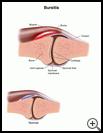
Bursitis
________________________________________________________________________
KEY POINTS
- Bursitis is irritation and swelling a fluid-filled sac that acts as a cushion between bone and other tissues, such as skin, muscle, tendons, or ligaments. There are many bursae in your body, for example, in the elbow, hip, knee, shoulder, and other joints.
- Treatment may include removing fluid from the swollen area with a needle and syringe, medicine, or surgery.
- It may help prevent bursitis if you warm up properly and do stretching exercises before sports or other physical activities. You may need to cut back on or stop doing whatever causes your bursitis. Avoid pressure and injury to joints by wearing protective pads.
________________________________________________________________________
What is bursitis?
Bursitis is irritation and swelling of a bursa. A bursa is a fluid-filled sac that acts as a cushion between bone and other tissues, such as skin, muscle, tendons, or ligaments. Tendons are strong bands of tissue that attach muscle to bone. Ligaments are strong bands of tissue that connect one bone to another to form the joints.
There are many bursae in your body, for example, in the elbow, hip, knee, shoulder, and other joints.
With treatment, the pain and swelling of bursitis usually goes away in 1 or 2 weeks. Even when the swelling goes away, the lining of the bursa may be replaced by tough, scar-like tissue that can cause symptoms for some time.
What is the cause?
Common causes of bursitis include:
- Injury to a joint, for example, from a fall
- Overuse injuries of a joint during sports, work, or hobbies
- Infection from a cut or a scrape on the skin over a bursa
Other possible causes or risk factors for developing bursitis include:
- Arthritis, which is pain and swelling of a joint
- Gout or pseudogout, which is pain and swelling caused by a buildup of crystals in your joints and under your skin
- An autoimmune disease, such as rheumatoid arthritis or lupus, which causes your body to mistakenly attack your own tissue
What are the symptoms?
Symptoms may include:
- Swelling and redness near a joint
- Pain in the joint
- Stiffness or trouble moving the joint
If the bursa is infected, you may have a fever and the swollen area may feel warm.
How is it diagnosed?
Your healthcare provider will ask about your symptoms and medical history and examine you. Tests may include:
- An ultrasound, which uses sound waves to show pictures of the joint
- Joint aspiration, which uses a needle and syringe to remove a sample of fluid from the bursa. The fluid can be checked for infection and other causes of the bursitis. Removing some of the fluid can also help the pain.
You may have tests or scans to check for other possible causes of your symptoms, such as blood tests, X-rays, or an MRI, which uses a strong magnetic field and radio waves to show detailed pictures of the joint
How is it treated?
To relieve symptoms of bursitis:
- You may need to change or stop doing the activities that cause pain until the bursa has healed. Do not put any pressure on the sore area while it is swollen. For example, don’t kneel on a swollen knee.
- Put an ice pack, gel pack, or package of frozen vegetables wrapped in a cloth on the area every 3 to 4 hours for up to 20 minutes at a time to help relieve pain.
- Wear a compression wrap around the joint (such as the elbow or knee) while the bursa is swollen.
- Take nonprescription pain medicine, such as acetaminophen, ibuprofen, or naproxen. Read the label and take as directed. Unless recommended by your healthcare provider, you should not take these medicines for more than 10 days.
- Nonsteroidal anti-inflammatory medicines (NSAIDs), such as ibuprofen, naproxen, and aspirin, may cause stomach bleeding and other problems. These risks increase with age.
- Acetaminophen may cause liver damage or other problems. Unless recommended by your provider, don't take more than 3000 milligrams (mg) in 24 hours. To make sure you don’t take too much, check other medicines you take to see if they also contain acetaminophen. Ask your provider if you need to avoid drinking alcohol while taking this medicine.
- Follow your provider’s instructions for doing exercises to keep your range of motion, keep the joint from getting stiff, and help the joint get stronger.
Bursitis caused by an infection may be treated with antibiotics.
If you keep having symptoms:
- Your healthcare provider may remove fluid from the swollen area with a needle and syringe. Your provider may then wrap the injured site or put a splint on it to keep fluid from refilling the area and to prevent you from moving it.
- Your provider may inject the inflamed area with a steroid medicine and a local anesthetic so you will have less swelling, redness, and pain.
- Your provider may recommend surgery to take out the bursa if the joint keeps bothering you even after treatment.
Follow the full course of treatment prescribed by your healthcare provider. Ask your provider:
- How and when you will get your test results
- How long it will take to recover
- If there are activities you should avoid and when you can return to your normal activities
- How to take care of yourself at home
- What symptoms or problems you should watch for and what to do if you have them
Make sure you know when you should come back for a checkup. Keep all appointments for provider visits or tests.
How can I help prevent bursitis?
It may help prevent bursitis if you warm up properly and do stretching exercises before sports or other physical activities. You may need to cut back on or stop doing whatever causes your bursitis. Avoid pressure and injury to joints by wearing protective pads.

